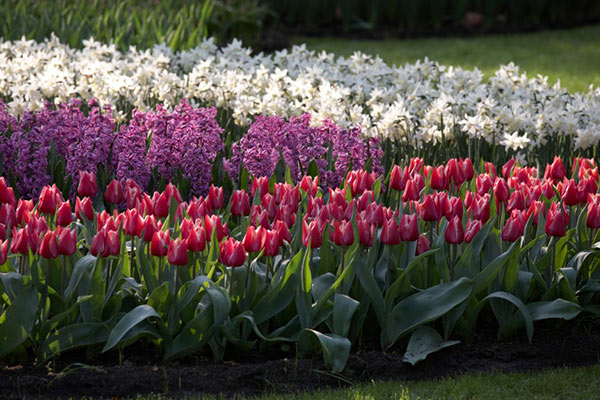What Are Fall Bulbs?
Beginners and garden pros alike love fall bulbs. Sometimes called hardy bulbs or spring flowering bulbs, these flower bulbs are planted in the cool, pleasant fall weather and burst into colorful blooms the following spring. Among the most popular fall planting bulbs are tulips, daffodils, crocus and hyacinths.
Fall bulbs require a cold period before they break their dormancy and flower. Spring planting bulbs, or tender bulbs, cannot withstand cold winter temperatures and often must be dug up in the fall. Fall bulbs are some of the easiest flowers to grow, require little care and usually come back every spring.
Flower Bulbs to Plant in Fall for Spring Blooms
Gardeners in most regions of the country can grow fall bulbs. Bulbs to plant in fall usually grow in zones 3 to 9, depending on the type. Before buying bulbs for fall planting, determine your USDA Hardiness Zone to see if the bulbs will grow in your area.
You can choose from a wide variety of flower bulbs to plant in fall—and with a little planning, you can enjoy cheerful blooms for months. Here are some of the best bulbs to plant in fall.
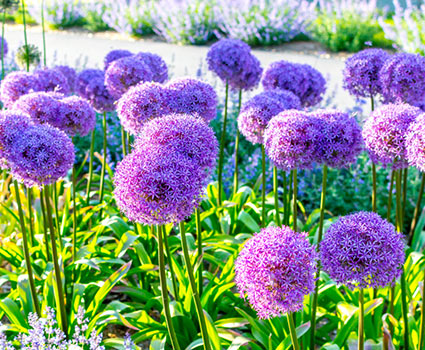
Alliums
One of the latest blooming of the spring-blooming bulbs, alliums add whimsy and charm to the garden with their spheres that rise above the foliage. They make great cut flowers, too. Some gardeners spray paint the dried flower heads to create a festive look.
- Bloom time: Late spring to early summer
- Height: 18-72 inches
- Grow zones: 4-9, depending on variety
- Attract pollinators
- Deer tend to avoid
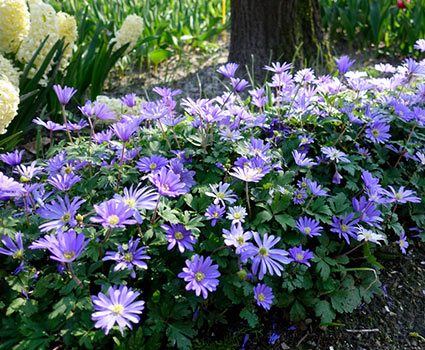
Anemones
These low-growing plants sport cheerful, daisy-like flowers. They’re ideal for planting in drifts and front borders where they add welcome color with their masses of blooms that may last 4-6 weeks.
- Bloom time: Mid to late spring
- Height: 3-4 inches
- Grow zones: 5-9
- Attract pollinators
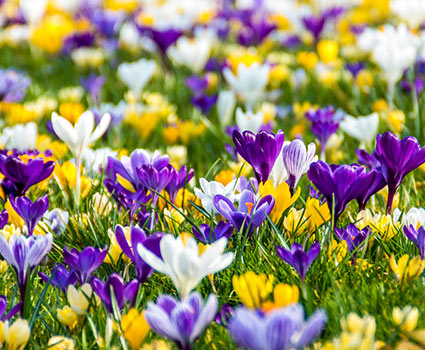
Crocus
A long-time favorite, these early bloomers are a welcome sight in early spring—and they’re versatile too. They can be planted in beds, borders, woodland areas, under trees and even in lawns.
- Bloom time: Early spring
- Height: 4-6 inches
- Growing zones: 3-9
- Naturalize well
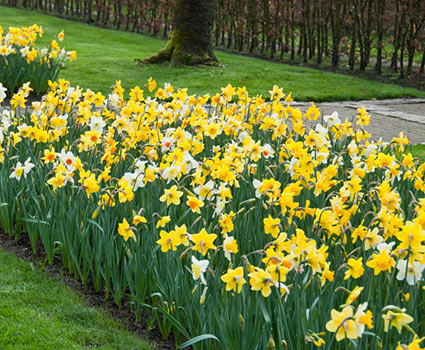
Daffodils
One of the most popular spring-blooming bulbs, daffodils, sometimes called narcissus, provide bold colors to flower beds, around trees and in naturalized areas. By planting early, mid and late varieties, you can enjoy these flowers all spring.
- Bloom time: Early to late spring
- Height: 14-18 inches
- Grow zones: 4-9
- Deer tend to avoid
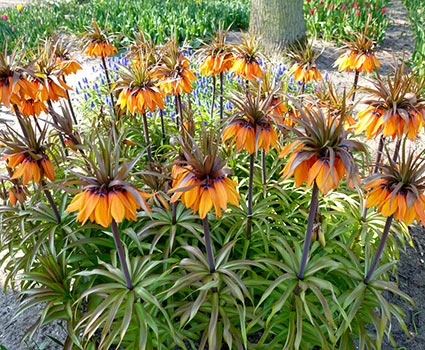
Fritillaria
A lesser known, but memorable, flower bulb, fritillaria adds bold color and an exotic look to the landscape. For the most impressive display of pendulous blooms, plant these spring-bloomers in clumps.
- Bloom time: Mid spring
- Height: 36-48 inches
- Grow zones: 4-8
- Deer tend to avoid
- Attract pollinators
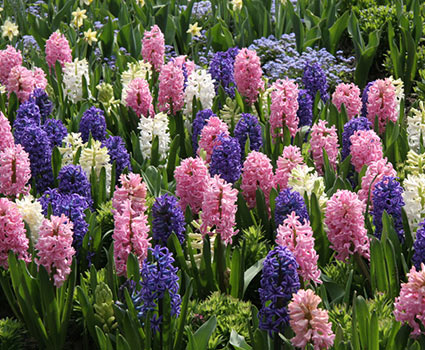
Hyacinths
Some of the most fragrant of the spring-blooming flowers, hyacinths perfume the spring air. They’re ideal for beds and borders, as informal accents in perennial beds and in containers.
- Bloom time: Early to mid spring
- Height: 8-12 inches
- Grow zones: 4-9
- Deer tend to avoid
- Container friendly
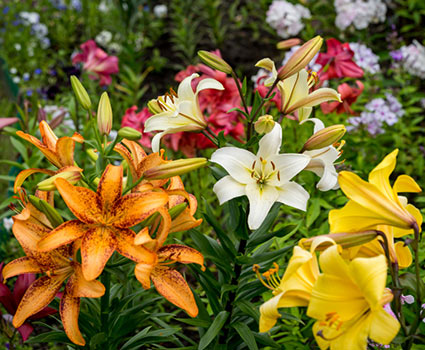
Lilies
Lilies are favorites in the garden and as cut flowers—and with so many to choose from, a gardener can enjoy lily flowers all summer long. Select from Asiatic Lilies, Oriental Lilies, Border Lilies and Giant Lilies.
- Bloom time: Early to late summer
- Height: Varies depending on type
- Grow zones: 3-8
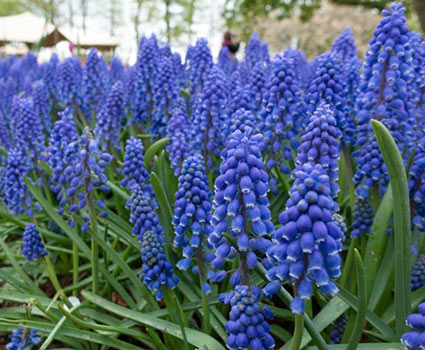
Muscari
Also known as grape hyacinths, muscari has clusters of flowers that add color and style to the spring landscape. Easy to grow and long lived, they’re ideal for growing in masses under trees and shrubs.
- Bloom time: Mid to late spring
- Height: 6-8 inches
- Grow zones: 3-9
- Deer tend to avoid
- Naturalize well
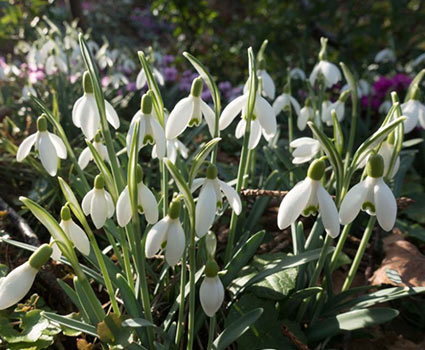
Snowdrops
One of the earliest of the spring-blooming bulbs, snowdrops often appear pushing through the snow. They’re ideal as a ground cover and in mass plantings and also complement crocus and hellebores.
- Bloom time: Late winter to very early spring
- Height: 6 inches
- Growing zones: 3-9
- Naturalize well
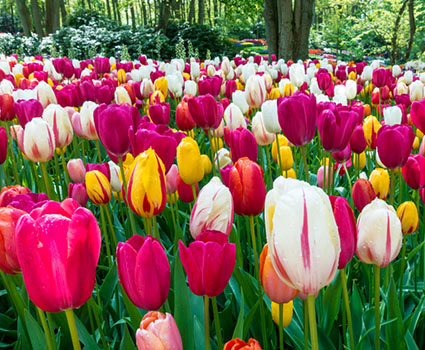
Tulips
These traditional favorites brighten gardens and vases. They fit well in formal gardens, borders, containers and bulb gardens. By choosing different varieties, you can enjoy up to three months of tulip flowers. Choose from Darwin Hybrids, Triumphs, Parrots, Species and so many more.
- Bloom time: Spring
- Height: 18-24 inches
- Grow zones: 3-8
Tips for Growing Fall Bulbs
Give Fall Bulbs the Right Growing Conditions
Flower bulbs need well-drained soil that is rich in organic matter. If the soil drains poorly, the bulbs can rot. Most fall bulbs require full sun, or 6-8 hours of direct sunlight daily. When considering where to plant fall bulbs, remember that many areas under deciduous trees receive full sun in late winter and early spring and are good places to plant fall bulbs that bloom in early spring.
Planting Fall Bulbs
When planning your fall bulb plantings, consider the plants’ mature height and spread as well as their bloom time. Also keep in mind that flower bulbs look best when planted in groups.
Bulbs can be planted individually using a bulb planter. You can also prepare a flower bed and plant lots of flower bulbs. The planting depth for your bulbs will depend on their size. Generally, the depth is about three times the diameter of the bulb. Plant the bulbs with the pointed end up.
How to Fertilize Fall Bulbs
Fall bulbs are usually fertilized at planting time. We recommend Van Bourgondien 100% Natural Bulb Food and suggest avoiding strong commercial fertilizer or fresh manure at planting time. As a general guideline, you can feed again with a natural food when foliage and flower spikes emerge.
What to do after the Flowers Bloom
You can enjoy flowers year after year if you allow the foliage to fade naturally after the flowers are done blooming. The bulbs need the foliage to make food for next year’s flowers.
